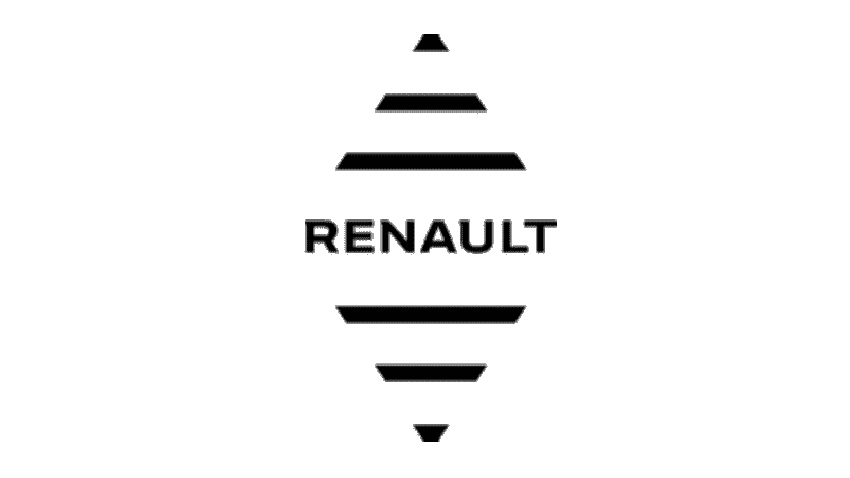In 1898, when a young engineer named Louis Renault built his first car and equipped it with the first-ever transmission, the history of the Renault automobile brand began. A year later, Louis and his brothers Fernand and Marseille founded the company, which they called the Renault Brothers. In the 1950s, Renault entered the international market. Then the factories of the company were opened in Spain, England, South Africa, and Japan.
Meaning and History
The Renault logo, as it is known today, was introduced to the public in 1992. Each of its details has a special meaning and describes the specific qualities of the company and cars. For example, silver stands for sophistication and creativity, while yellow stands for prosperity and optimism.
1899 – 1906
The first company logo was created only in 1900. The emblem consisted of the company’s founder’s initials (brothers Ferdinand, Marcel, and Luis Renault), which were enclosed in an oval, decorated with a patterned ribbon on top.
1906 – 1919
In 1906, the initials of the founders disappeared from the Renault logo. A car appeared in their place. The car, resembling an old carriage, was located in a circle, the inside of which resembled a gear.
1919 – 1923
At that time, a tank replaced the car in the logo. And this was due to the fact that during the First World War, the factories of the French company Renault changed their specialization. The company started producing military equipment. Such significant changes in production simply could not be unreflected in the company’s logo.
1923 – 1925
The first Renault brand logo that adorned the company’s car was created in 1923. It had a round shape and was simply the inscription “Renault”, placed on the radiator grille.
1925 – 1946
The diamond-shaped logo, which is more familiar to us, was developed by designers in 1925. It was the same “Renault” inscription in the center of the radiator, but with a diamond-shaped grille.
1930 – 1945
The Renault logo was a black diamond, lined with white horizontal stripes, in the middle of which the name of the Renault brand was written.
1945 – 1946
In 1946, the company logo first became colored. During this period, the European automotive industry was experiencing a rebirth, and the company’s management decided to update the emblem. Renault’s logo was painted a rich yellow. This color is still rarely used by automakers for corporate identity and corporate design, and that makes the logo so recognizable.
1946 – 1958
In 1946 the brand continues using yellow and makes its badge sharp and geometric again. It was the logo from 1926 but with narrowed rhombus hand sharper angles. The background was now bright yellow, with thin black horizontal lines, and the middle was colored in white, with the black “Renault Regie National” in the upper-case set in two lines, executed in a modern sans-serif typeface.
1959 – 1971
In 1959, the logo became monochrome again. The center inscription was enlarged.
1971 – 1972
A more abstract geometric badge was introduced in 1971. The yellow became darker and moved to the rectangular background, on which two white vertical chev-rons were placed facing together and forming a yellow rhombus in the negative space. The lettering was now set under the yellow rectangular, between two black horizontal lines. The font was switched to a bolder and more confident one.
1972 – 1981
In 1972, the simplest version of the logo was presented — an empty rhombus, without text and other graphics, drawn with a triple line with the effect of volume (“ribbon folding”).
1981 – 1992
The redesign of 1982 introduced a refined gradient gray and black Renault diamond, set on a dark yellow background above the bold serif “Renault” logotype in all capi-tals. The Diamond had two parallel sections in dark gray and black, and the other two — in white and black. And it added volume and vitality to the whole composi-tion.
1992 – 2004
In 1992, a new appearance of the Renault logo was developed. The text returned to this version of the emblem again. But, being already recognizable, the rhombus ceases to be the center of the composition. A more simplified geometric figure was positioned above the Renault lettering, exactly in the middle.
2004 – 2007
The redesign of 2004 made the logo three-dimensional and brought back the yellow and gray color palette. Now the Renault badge was executed in gradient silver, with a matte texture and softened angles, looking smooth and sleek. The lettering got enlarged and became the main element of the visual identity. The black uppercase inscription was executed in a custom stylish typeface with sharp elements of the letters.
2007 – 2015
During this period, the inscription was placed under the rhombus, and the yellow background was increased over the entire image. The rhombus itself eventually became silver-gray, chrome-plated, voluminous. So it remains nowadays.
2015 – 2021
The composition of the Renault logo was changed in 2015. This is when the emblem got placed on the left from the lettering. The whole logo got a new palette — black and white, which added a modern and confident feeling. The badge still looked three/dimensional due to the use of gray and black gradients. As for the let-tering, its typeface was changed to a more contemporary one and the letters got a bit wider, getting more space between the bars.
2018
This year’s logo strongly resembled the logo of 1390-1945. It was also a white diamond lined with black horizontal stripes with the inscription Renault in the center in black letters.
2021 – present
The version, created for Renault in 2021, is based on the iconic Diamond emblem but drawn in a minimalist geometric way. It is now executed in two bold clean black lines, placed on a white background without any lettering accompanying it. It looks fresh and young and brilliantly reflects the ability of the legendary marque to change with the world and its trends.
The Legends
Renault Juvaquatre
This car debuted at the 1937 Paris Motor Show. Over the years, they made two-door cars with a closed or open body, four-door sedans, vans, and station wagons, as well as coupes with a 2 + 2 landing formula.
Renault Vivastella PG7
Renault Vivastella is an executive car introduced by Renault in October 1928 and produced during 1929-1939. The car was changing at an unusual rate even by Renault standards in the 1930s.



















